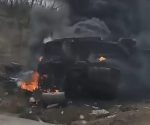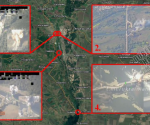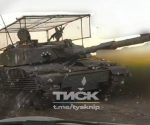Comprehensive Russian Ministry of Defence briefing provides vindication
This article consists of material that was intended to form part of the piece, The Russian Way of Warfare, but it became clear that it should be separated out on its own. The comprehensive briefing by the Russian Defence Ministry, held on 25th March, constitutes the source material for what is now two separate articles, but in this one, the intention is to use it to prove FBEL coverage of the events in and about Ukraine in February and March of this year. In the second article, the briefing will be used in an explanation of how the Russian military is conducting itself in Ukraine, so that although Anglo-globalist media can misrepresent the Special Operation as a would-be bludgeoning always encountering problems, and thus in need of modification, what actually can be shown with the available evidence is the Russian’s engaged in a more surgical exercise to remove the source of a deeply unpleasant mischief in Ukraine, and in doing so, only inflicting war in space enough required for the operation, instead of subjecting all of Ukraine to US/UK-style wanton destruction.
So, as mentioned above, on 25th March, the Russian Ministry of Defence gave what was possibly its most comprehensive presentation so far regarding the progress of their “Special Operation in the Donbas”, and analysis produced by this site was vindicated by it. Indeed, there’s only one error that the author made. It wasn’t, of course (because there’s better sense had here than to do it), the regurgitation of US/UK/Ukrainian propaganda (of the sort one could find in the comments sections of big alternative media so-called geo-political experts, if not actually in their articles) regarding large Russian casualties in the first advances of the conflict when, as the false narrative appears to go, Russian armour ran into Ukrainian infantry screens (for armour that had taken its own big losses from Russian air attack) and became vulnerable to anti-tank weapons. The reader will perhaps have seen US/UK media claims of great Ukrainian successes in these regards; the author has found one that provides a very good demonstration of the nebulous nature of the claims:
As of March 13, the Ukrainians have lost 389 tanks and 1,249 armored personnel carriers, according to the Ukrainian ministry of defense quoted in the Kyiv Independent. While these numbers are not independently confirmed, it is safe to say that the Russians have seen hundreds of tanks destroyed.
As for casualties in terms of lives, here is an example from CBS:
Between 5,000 and 6,000 Russian troops may have been killed in just the first two weeks of the invasion of Ukraine, a U.S. official estimated.
In actual fact, the Russian briefing given by Colonel General Sergei Rudskoy, the head of the Main Operational Directorate of the General Staff of the Armed Forces of the Russian Federation, when he stated that 1,351 Russian servicemen had thus far been killed, with 3,825 wounded, creates grounds to say that the story of Ukrainian tank-busting exploits is pure fantasy. Moreover, it becomes possible to see exactly how they are fantasy when one understands how Russia employs a stand-off method of fighting that implements devastating, proportionally superior artillery firepower – all stuff for The Russian Way of Warfare article.
The error that is being referred to was to assume that Russia was closing large pincers at the back of the Donetsk-Luhansk front in a physical way on the ground, as in soldiers of one wing coming face-to-face with their counterparts in the other. It is tempting to do this when one has seen too-optimistic maps that are promoted by alternative media that ultimately disseminates US/UK propaganda by offering, on the surface of it, good news to an audience which has picked the Russian side. Moreover, when one is invited in this way to imagine very mobile forces rushing to conjoin – and in fact, therefore, be mistaken about how Russia is equipped to carry out its venture (and also risk falling prey to stories of Ukrainian anti-tank glory, etc) – one is led to understand that there will be an outcome that then never appears to materialise.
This is not to say that a closed pincer is not in effect virtually, especially judging by the way that the forces of Donetsk and Luhansk are fighting forward through the Ukrainian positions that face them. This situation, where a lock is in place that appears to prevent significant Ukrainian movement to and from the Donetsk-Luhansk front, appears to owe itself to a combination of Russian air power and the ability of the Russians to pin down their enemy in other parts of Ukraine (after having destroyed a lot of capability, even in the first days of the conflict, that might have prevented them from doing it). This strict control of the battlefield, of course, is something that FBEL has explained before, and has now been confirmed by the Russian MoD briefing – but we’ll get to this by and by.
To begin at the beginning, the reader will no doubt remember the incredible amount of noise in media of all sorts, framed by the military-political rulers of the US/UK. This site consistently said one thing about it: the Ukrainians had been put on a trajectory of a lightning war, by their masters, into the separatist states of Novorossiya (and even into Crimea), but come time for the launch, there was much dismay in the US/UK because Russia had positioned itself to react and spoil.
As it now as happened, the Russian MoD has provided clearer information regarding data that was captured regarding Ukrainian invasion plans. This is Major General Igor Konashenkov (emphasis added):
I want to show you once again the originals of the secret cipher telegrams of the 4th brigade of the National Guard of Ukraine captured by Russian servicemen.
The document is addressed to the heads of the northern Kiev, southern Odessa and western territorial administrations of the National Guard of Ukraine.
The order details a plan for the preparation of one of the strike groups for offensive actions in the zone of the so-called “joint forces operation” in the Donbass.
I especially want to draw your attention. All measures of the nationalists’ combat coordination are ordered to be completed by February 28. In order to start performing combat missions as part of the Ukrainian “joint forces operation” in the Donbass in March 2022.
Since February 2022, Ukrainian troops have multiplied artillery attacks on Donbass with prohibited large-caliber artillery weapons.
Against the background of false statements about the desire for peace, Kiev has begun large-scale artillery preparations for the offensive of a shock group of troops drawn to the east of Ukraine with the support of aviation and missile systems.
A special military operation launched by the Russian Armed Forces on February 24 thwarted a large-scale offensive by shock groups of Ukrainian troops on the Lugansk and Donetsk People’s Republic…
The obvious thing to say about the information under discussion, especially as far as we are concerned when it comes to dates, is that it doesn’t have to be true. Indeed, because it is captured information is an especial reason to treat it suspiciously. So, the real value of this information is that it is a source that the Russians can afford to make public to demonstrate their foreknowledge of intended Ukrainian aggression, and this is the one thing to take from all this so as to appraise the consistent analysis at FBEL by it.
But to widen the discussion a little and prove the idea of foreknowledge, because it would be stupid indeed to think that the Russians could only find out about US/UK/Ukrainian intent during the course of an action that would then amount to an accidental intervention. Indeed, the military exercise in Belarus, which was evidently turned into a staging of troops for what was to come, happened in February 2022, and the author still sticks with the idea expressed in the article, With February Offensive By Puppet Scuppered, US/UK’s Ukraine Crisis Reverts To Being Purely Ministry Of Truth Nonsense, based on evidence presented there, that the Russians acted because of a belief that something finally beyond the pale had supposed to have happened in that month. The article, The Attack On The Yavorov International Peacekeeping And Security Centre; Part One: Without Thought Or Fear Of US/UK Retaliation, is in part a follow-up piece that points out that even so, the Special Operation would not have been a knee-jerk reaction.
Of course, 24th February was the first day of the Russian police action, and on the following day, an article was published at FBEL entitled, By Its Looks, Russia’s “Special Military Operation In Donbas” Really Is Just That. The following is an extract from it:
It would appear, then, that the Russians are indeed executing an operation that is more limited than it could be: i.e. not the “full invasion” that US/UK corporate-media and politicians complain about. Instead the expulsion of Ukrainian forces from Novorossiya – after their destruction or surrender (and disarmament) – is about the liberation of Luhansk and Donetsk. The move on the capital city not only deals with the head of the snake in terms of its ability to conduct a defence in Novorossiya, but it has the added bonus of bringing pressure to bear on the Kiev government in terms of achieving broader objectives in respect of establishing Russian security.
The following is from the March 12th FBEL article, Utilising Mi7 Propaganda To Tell The Story Of Russian Success In Ukraine It Doesn’t Want To:
It stands to reason (and anyone should be able to realise this without having attended West Point) that if an army wants to exert a very tight sort of control over a battlefield, it must engage the enemy at as many points of contact as possible in order to pin them down, and advance at most of these points will not be the objective. On the other hand, at other points, usually where an army can act most decisively, the entire objective will be to push through an offensive. In support of this, the stationary points of combat are for keeping the enemy under control so that one can achieve one’s own manoeuvres. Looking at the better of these maps (so, not the BBC one), the author would argue that, the Russians have engaged the Ukrainians every where they can for the main purpose of destroying the Ukrainians on their Novorossiyan front with pincers from the south and the east. The objective at Kiev in the early days, then, would not have been so much about disconnecting it, as it would be about the general requirement of keeping the Ukrainians from reinforcing the south. Moreover, because the author is led to understand that the vast bulk of the Ukrainian forces were on their Novorossiyan front at the beginning of the Russian operation, there is cause to believe, from looking at these maps, that they don’t have forces in reserve, and any that are not in the Novorossiyan pocket are trapped where they have been engaged by the Russians. Now, recall if you will reader, another stated objective of the Russian mission is to demilitarise Ukraine. It’s quite clear that to do this in the circumstances presented to them, the Russians had to crush the army in the south as compulsory prerequisite. What, then, matters control of Kiev if this is going on, and the Ukrainians cannot reinforce? In this case, there is no point to any command and control to be effected from Kiev that the Russians need to decapitate.
So to summarise, the author quickly recognised the scale of the operation, whereby Kiev was an incidental component part of the operation, albeit quite important because of its special status assuming that government was based there, but also then saw in the development of the information available to him that Kiev was not the specially significant target as it was made out to be by all the expertise, and possibly never had been. Indeed, even today the Russians appear to be announcing some kind of drawdown around the capital city.
Now, the following are pertinent parts extracted from the speech given at the Russian MoD briefing by the above introduced Sergei Rudskoy:
[The Special Operation’s] main goal is to provide assistance to the people of the Lugansk and Donetsk people’s republics, who have been subjected to genocide by the Kiev regime for 8 years…
There were two possible courses of action.
The first is to limit the territory to only the DPR and the LPR within the administrative borders of the Donetsk and Lugansk regions, which is enshrined in the constitutions of the republics. But then we would be faced with constant feeding by the Ukrainian authorities of the grouping involved in the so-called joint force operation.
Therefore, the second option was chosen, which provides for actions throughout the territory of Ukraine with the implementation of measures for its demilitarization and denazification…
The public and individual experts are wondering what we are doing in the area of blocked Ukrainian cities.
These actions are carried out with the aim of causing such damage to military infrastructure, equipment, personnel of the Armed Forces of Ukraine, the results of which allow not only to shackle their forces and do not give them the opportunity to strengthen their grouping in the Donbass, but also will not allow them to do so until the Russian army completely liberates the territories of the DPR and LPR.
Initially, we did not plan to storm them in order to prevent destruction and minimize losses among personnel and civilians.
And although we do not rule out such a possibility, however, as individual groups complete their tasks, and they are being solved successfully, our forces and means will concentrate on the main thing – the complete liberation of Donbass.
The first part, then, talks about the main focus being the territories of Luhansk and Donetsk, with military measures to be taken further afield in support – just as this site explained to its readers.
The second part talks about the necessary pinning down of other Ukrainian forces – again, as explained at this site – and we should note that if the Russians are also now drawing down in some fashion or other around more places than Kiev, such as Chernigov [Chernihiv], (prompting Mi7 to comically declare that Russia is being beaten back, then from Rudskoy’s comments we can deduce that such is the situation towards the main objective, a decision has been made that the pressure that has been exerted at these places need no longer be applied.
Now consider the following extracts from two separate FBEL articles. The first is from, Utilising Mi7 Propaganda To Tell The Story Of Russian Success In Ukraine It Doesn’t Want To (published March 12th):
The truth is that effective Russian control of the east looks to be complete, with Mi7 only being able to boast on behalf of the Ukrainians about ambushes, which if the Ukrainians (and their helpers) are able to carry out successfully here and there, most likely are done in areas of Russian control (and by infiltrating saboteurs), or as rearguard actions against forces coming to control new territory. There are no Ukrainian counter offensives, it would seem, and no reinforcement, otherwise the Russian air force would be more busy than it is said to be over central Ukraine
The second is from The Attack On The Yavorov International Peacekeeping And Security Centre; Part Two: Making Waste Of US/UK “Capabilities” (published March 21st):
In any case, the point is that here, in Nova Lyubomyrka and Ovruch, are two candidates for attacks involving the same circumstances as existed at Yavorov, with plenty of reasons to be suspicious regarding the type of military being housed there. Not only it is evidence of failure for the US/UK’s plan to reinforce and resupply, but it means actual losses of US/UK capability even if that only extends to weaponry, although in fact, we should suspect that there has also been loss of in-service manpower.
In addition, let’s repeat a portion of the extract printed towards the top of the page, in case the reader glanced through it and didn’t appreciate the significance:
Moreover, because the author is led to understand that the vast bulk of the Ukrainian forces were on their Novorossiyan front at the beginning of the Russian operation, there is cause to believe, from looking at these maps, that they don’t have forces in reserve…
What is being talked about here is what the Russians have called the “demilitarisation” of Ukraine, which – as the reader can see – appeared even to this layman to be quite comprehensive. Here is Rudskoy:
Demilitarization of Ukraine is achieved both by high-precision strikes on military infrastructure facilities, locations of formations and military units, airfields, control points, arsenals and warehouses of weapons and military equipment, and by the actions of troops to defeat opposing enemy groupings (sic)…
All 24 formations of the Land Forces that existed before the start of the operation suffered significant losses. Ukraine has no organized reserves left…
At the time of the start of the special military operation, the Armed Forces of Ukraine, together with the National Guard, numbered 260 thousand 200 servicemen. During the month of hostilities, their losses amounted to about 30 thousand people, including more than 14 thousand – irretrievable and about 16 thousand – sanitary.
Of the 2,416 tanks and other armored fighting vehicles that were in combat on February 24, 1,587 units were destroyed; 636 units out of 1,509 field artillery guns and mortars; 163 out of 535 MLRS; 112 out of 152 aircraft, 75 out of 149 helicopters; 36 Bayraktar TB2 UAVs – 35;
180 out of 148 [148 from 180?] S-300 and Buk M1 air defence systems; 300 out of 117 [117 from 300?] radars for various purposes…
Today, the number of foreign mercenaries is declining. This was facilitated by high-precision strikes on their bases and training camps. On March 13, more than 200 militants were killed and more than 400 wounded in Starichi and at the Yavorovskii training ground alone.
I note that not a single foreign mercenary has arrived in Ukraine in the last seven days. On the contrary, there has been an outflow. Within a week, 285 fighters escaped into Poland, Hungary and Romania, I hope without Stingers and Javelins…
At the beginning of the special military operation, the LPR and DPR people’s militias were confronted by a group of 59,300 people comprising the most combat-ready units of the Ukrainian Armed Forces, the National Guard and nationalist formations.
As a result, Ukraine’s security forces in the OOS zone lost about 16,000 people, or 26% of their total strength as of 24 February this year.
More than 7,000 of them were irrecoverable losses.
Replacing losses is prevented by isolating the Ukrainian grouping of troops in Donbass, taking control of railway stations and key road routes with firepower.
The supply of missiles and ammunition, fuel and food to Ukrainian forces has been almost completely halted.
Now, the reader will probably have noticed a good deal of chatter about pending peace deals – not to be surprised at, given that Ukraine is being defeated according to the Russian goals so that both sides must see the inevitable outcome (and Russia indicates this with the draw downs). Unfortunately, a lot of people are going to suffer from relying on poor alternative media, that just isn’t diabolical in terms of not being as expert as it claims, but is also deliberately deceptive (and ultimately does nothing to reverse the incorrigible alt-media audience moronism). For instance, if people don’t understand why Ukraine isn’t going to be partitioned, with the Poles coming in on the west representing a bone thrown to NATO – which is what one famous alternative media so-called geopolitical expert groomed his audience to expect – then there will inevitably be disappointment, and a feeling that Russia did not meet its criteria for success.
Of course, none of this would be relational to actual stated Russian goals, and the distortion would have been wholly due to an experience of the conflict through the prism of rottenly bad alternative media.
And it is for the purpose of helping steer perceptions to be had by events so that they avoid malicious deformation that a word should be had about the Russian sub-objective of denazification. As far as the author is aware, this term has never been officially defined with regards to what extent soldiers and artillery can deal with it, and alternative media audience have probably been led to believe that it is something solvable entirely by an armed conflict (like they are led to believe that Russia wants to return NATO to pre-eastern expansion borders by bombing Poland). The author took the following view:
Although it has been stated as a separate aim, the denazification of Ukraine is part and parcel of the demilitarisation because of how the regime is evidently a martial one stemming from the relationship with government had by a Nazi political element, with its own battalions assimilated into the Ukrainian army, and forming its elite forces, that is akin to a praetorian one.
However, it is clear, what with the inevitable civilian component of any government, no matter how martial it is, demilitarisation alone is not going to solve what is a political problem. Likewise, a military peace should perhaps not be expected to solve it either. Moreover, with its limited aims, the Russians would not have been trying to bring regime change (and have always said that the Ukrainians must decide their own future). However, that being said, this Russian Special Operation has been full of surprises, and by no means is it over yet, and one outside the planning of Russia and its allies cannot know what ramifications there will be; i.e. a court, perhaps, targeted at the Ukrainian Nazis (conceived and given authority by the “Global South”, for the US/UK will not authorise it). Time will tell.


















